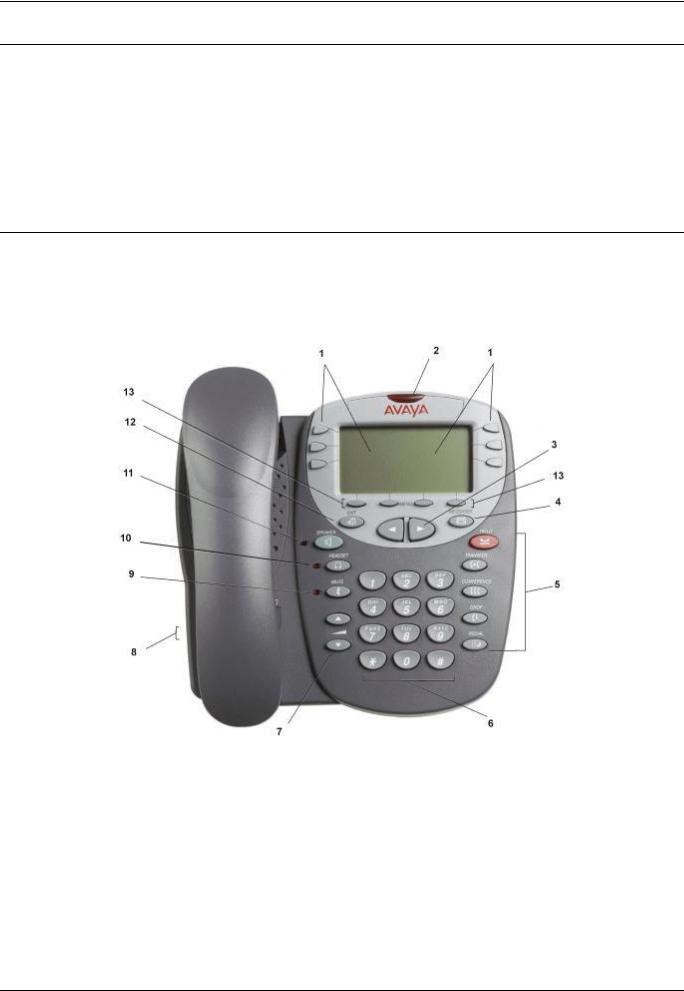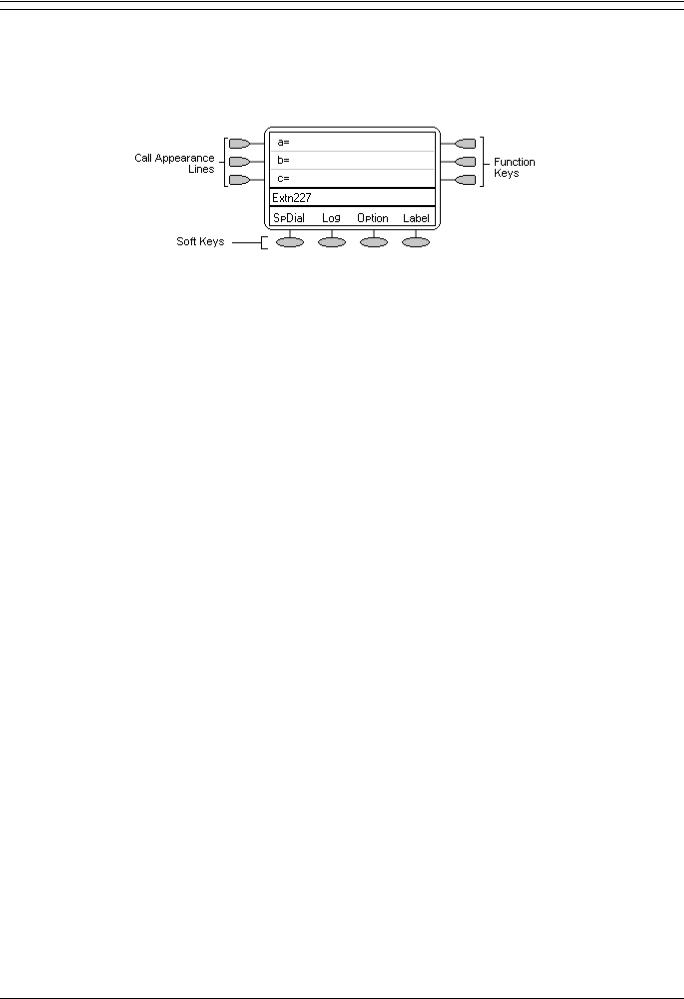Avaya 2410, 5410 User Manual

IP Office 3.2
2410 and 5410 User Guide
[15-601076] Issue [4] (5 June 2006)
© 2006 Avaya Inc. All Rights Reserved.
Notice
While reasonable efforts were made to ensure that the information in this document was complete and accurate at the time of printing, Avaya Inc. can assume no liability for any errors. Changes and corrections to the information in this document may be incorporated in future releases.
Documentation Disclaimer
Avaya Inc. is not responsible for any modifications, additions, or deletions to the original published version of this documentation unless such modifications, additions, or deletions were performed by Avaya.
Link Disclaimer
Avaya Inc. is not responsible for the contents or reliability of any linked Web sites referenced elsewhere within this Documentation, and Avaya does not necessarily endorse the products, services, or information described or offered within them. We cannot guarantee that these links will work all of the time and we have no control over the availability of the linked pages.
License ’
USE OR INSTALLATION OF THE PRODUCT INDICATES THE END USER S ACCEPTANCE OF THE TERMS SET FORTH HEREIN AND THE GENERAL LICENSE“ TERMS AVAILABLE ON THE” AVAYA WEBSITE AT http://support.avaya.com/LicenseInfo/ ( GENERAL LICENSE TERMS ). IF YOU DO NOT WISH TO BE BOUND BY THESE TERMS, YOU MUST RETURN THE PRODUCT(S) TO THE POINT OF PURCHASE WITHIN TEN (10) DAYS OF DELIVERY FOR A REFUND OR CREDIT.
Avaya grants End User a license within the scope of the license types described below. The applicable number of licenses and units of capacity for which the license is granted will be one (1), unless a “different number of licenses” or units of capacity is specified in the Documentation“ ” or other materials available to End User. Designated Processor means a single stand-alone computing“ ” device. Server means a Designated Processor that hosts a software application to be accessed by multiple users. Software means the computer programs in object code, originally“ licensed” by Avaya and ultimately utilized by End User, whether as stand-alone Products or pre-installed on Hardware. Hardware means the standard hardware Products, originally sold by Avaya and ultimately utilized by End User.
License Type(s): Designated System(s) License (DS).
End User may install and use each copy of the Software on only one Designated Processor, unless a different number of Designated Processors is indicated in the Documentation or other materials available to End User. Avaya may require the Designated Processor(s) to be identified by type, serial number, feature key, location or other specific designation, or to be provided by End User to Avaya through electronic means established by Avaya specifically for this purpose.
Copyright
Except where expressly stated otherwise, the Product is protected by copyright and other laws respecting proprietary rights. Unauthorized reproduction, transfer, and or use can be a criminal, as well as a civil, offense under the applicable law.
Third-Party Components
Certain software“ programs or portions thereof” included in the Product may contain software distributed under third party agreements“ ( Third Party Components” ), which may contain terms that expand or limit rights to use certain portions of the Product ( Third Party’ Terms ). Information identifying Third Party Components and the Third Party Terms that apply to them is available on Avaya s web site at: http://support.avaya.com/ThirdPartyLicense/
Avaya Fraud Intervention
If you suspect that you are being victimized by toll fraud and you need technical assistance or support, call Technical Service Center Toll Fraud Intervention Hotline at +1-800-643-2353 for the United States and Canada. Suspected security vulnerabilities with Avaya Products should be reported to Avaya by sending mail to: securityalerts@avaya.com.
For additional support telephone numbers, see the Avaya Support web site (http://www.avaya.com/support).
Trademarks
Avaya and the Avaya logo are registered trademarks of Avaya Inc“®. in” “™”the United“ States” of America and other jurisdictions. Unless otherwise provided in this document, marks identified by , and SM are registered marks, trademarks and service marks, respectively, of Avaya Inc. All other trademarks are the property of their respective owners.
Documentation information
For the most current versions of documentation, go to the Avaya Support web site (http://www.avaya.com/support) or the IP Office Knowledge Base (http://marketingtools.avaya.com/knowledgebase/).
Avaya Support
Avaya provides a telephone number for you to use to report problems or to ask questions about your contact center. The support telephone number is 1- 800242- 2121 in the United States. For additional support telephone numbers, see the Avaya Web site: http://www.avaya.com/support.

Table Of Contents |
|
The Telephone............................................................................................................................ |
1 |
About this Guide....................................................................................................................................... |
1 |
Overview .................................................................................................................................................. |
1 |
Call Appearance Keys .............................................................................................................................. |
3 |
System Features.................................................................................................................................. |
4 |
Call Appearance Key Icons.................................................................................................................. |
4 |
The Display .............................................................................................................................................. |
5 |
Basic Call Handling Features.................................................................................................... |
6 |
Answering a Call ...................................................................................................................................... |
6 |
Making a Call............................................................................................................................................ |
7 |
Clearing a Call.......................................................................................................................................... |
7 |
Headset Working...................................................................................................................................... |
8 |
Speakerphone.......................................................................................................................................... |
9 |
Speed Dial................................................................................................................................................ |
9 |
Redial..................................................................................................................................................... |
10 |
Mute ....................................................................................................................................................... |
10 |
Hold........................................................................................................................................................ |
11 |
Transfer.................................................................................................................................................. |
12 |
Conference............................................................................................................................................. |
13 |
Message................................................................................................................................................. |
13 |
Using Speed Dials.................................................................................................................... |
14 |
Overview ................................................................................................................................................ |
14 |
Adding a New Speed Dial....................................................................................................................... |
15 |
Dialling a Speed Dial Number................................................................................................................. |
16 |
Deleting a Speed Dial............................................................................................................................. |
17 |
Editing a Speed Dial............................................................................................................................... |
17 |
Converting a Call Log Entry to a Speed Dial........................................................................................... |
17 |
Using the Call Log ................................................................................................................... |
18 |
Overview of the Call Log ........................................................................................................................ |
18 |
Using the Call Log .................................................................................................................................. |
19 |
Setting Which Calls are Logged ............................................................................................................. |
20 |
Viewing the Call Log............................................................................................................................... |
21 |
Making Calls from the Call Log............................................................................................................... |
21 |
Saving a Call Log Entry to Your Speed Dial List ..................................................................................... |
21 |
Deleting a Call Log Entry........................................................................................................................ |
22 |
Erasing All Logged Calls ........................................................................................................................ |
22 |
Changing Options .................................................................................................................... |
23 |
Changing Ringer Options ....................................................................................................................... |
23 |
Adjusting the Display Contrast................................................................................................................ |
24 |
Call Log Setup........................................................................................................................................ |
24 |
Miscellaneous......................................................................................................................................... |
24 |
Using Self Test ....................................................................................................................................... |
25 |
Language ............................................................................................................................................... |
25 |
Automatic Gain Control (AGC) ............................................................................................................... |
26 |
Default Phone/Erase All Settings............................................................................................................ |
26 |
Function Keys .......................................................................................................................... |
27 |
Overview of the Function Keys ............................................................................................................... |
27 |
Function Key Programming .................................................................................................................... |
27 |
Shorthand Programming Mode............................................................................................................... |
29 |
Longhand Programming ......................................................................................................................... |
30 |
Changing Function Key Labels............................................................................................................... |
31 |
2410 and 5410 User Guide |
Page iii |
IP Office 3.2 |
[15-601076] Issue [4] (5 June 2006) |

2410 and 5410 User Guide
System Features ...................................................................................................................... |
32 |
Introduction ............................................................................................................................................ |
32 |
Making Calls........................................................................................................................................... |
32 |
Answering Calls...................................................................................................................................... |
33 |
Call Forwarding ...................................................................................................................................... |
33 |
Diverting Calls ........................................................................................................................................ |
34 |
Do Not Disturb........................................................................................................................................ |
34 |
Voicemail................................................................................................................................................ |
35 |
Default Feature Codes ........................................................................................................................... |
36 |
Index.......................................................................................................................................... |
37 |
2410 and 5410 User Guide |
Page iv |
IP Office 3.2 |
[15-601076] Issue [4] (5 June 2006) |

The Telephone
About this Guide
This guide describes how to use all the features on your Avaya IP Office 2410/5410 phone.
For basic phone settings and functionality, refer to the relevant Quick Reference Guide for your IP Office phone.
Further information about IP Office is available from www.avaya.com/support and also from www.avaya.com/ipoffice/knowledgebase.
Overview
This guide covers the use of the 2410 and 5410 phones on IP Office. Both phones are similar, however the 5410 is only supported on the IP Office whereas the 2410 is supported on a range of Avaya phone systems.
2410 and 5410 User Guide |
Page 1 |
IP Office 3.2 |
[15-601076] Issue [4] (5 June 2006) |

2410 and 5410 User Guide
1.Display, Call Appearance and Feature Buttons: Call Appearance keys allow you to handle multiple calls and the display shows call information. Details on system features (allocated by your system administrator) can also be displayed. See Call Appearance Keys and Overview of the Function Keys.
2.Message Lamp: The lamp is used as follows:
On (Continuous): There are new messages in your voicemail mailbox, or another mailbox for which you have been configured to receive "Message Waiting Indication".
Flashing: The lamp can also be set to flash when the phone receives a call. See Ring Options.
3.
 Previous/Next Page: Move through the different pages of the call handling, speed dials and call log screens. Also used to move the cursor during data entry.
Previous/Next Page: Move through the different pages of the call handling, speed dials and call log screens. Also used to move the cursor during data entry.
4. Messages: Access your mailbox.
Messages: Access your mailbox.
5.Call Handling Buttons:
 Hold:
Hold:
Red button used to place a call on hold.
 Transfer:
Transfer:
Transfers a call to another phone.
 Conference:
Conference:
Sets up conference calls with more than one other person.
 Drop:
Drop:
Drops the current call or, if on a conference call, drops the last person to join the conference.
 Redial:
Redial:
Redials the last number dialed or displays the last 6 numbers dialed from the phone, depending on configuration via the Options menu.
6.Dial Pad: Standard 12-button pad for dialling phone numbers.
7.
 Volume Controls: Adjusts the speaker, handset, headset, or ringer volume depending on which is currently in use.
Volume Controls: Adjusts the speaker, handset, headset, or ringer volume depending on which is currently in use.
8.Handset and Headset Sockets: Used for connection of the handset and optional headset.
9. Mute: Turns the microphone on/off. When in use, the associated light is on and the caller cannot hear you.
Mute: Turns the microphone on/off. When in use, the associated light is on and the caller cannot hear you.
10. Headset: Switches from handset to headset. The light associated with this button turns on when the headset is active.
Headset: Switches from handset to headset. The light associated with this button turns on when the headset is active.
11. Speaker: Access the speakerphone. The light associated with this button turns on when the speakerphone is active.
Speaker: Access the speakerphone. The light associated with this button turns on when the speakerphone is active.
12. Exit: Returns you to the main call handling screen.
Exit: Returns you to the main call handling screen.
13.Softkeys: Used to navigate to or initiate certain features, such as Speed Dial or Call Log, as well as control certain actions within the features. These keys correspond to the text prompts in the display screen immediately above them.
2410 and 5410 User Guide |
Page 2 |
IP Office 3.2 |
[15-601076] Issue [4] (5 June 2006) |

The Telephone
Call Appearance Keys
Normally, the first page of the main call handling screen contains three keys set as 'Call Appearance' keys. These are allocated to you by your system administrator and are indicated as a=, b= and c=. An underscored call appearance key (e.g. a=) indicates that the line is active.
Your system administrator can allocate a Call Appearance key with:
A Bridged Appearance
A bridged appearance’ key matches the status and operation of the call appearance key on a predefined colleague s phone. Hence, you can pick-up, make and receive calls on behalf of your colleague.
A Line Appearance
An IP Office exchange line (but not IP lines) can be allocated to you such that the status of that line is displayed and you can use the line appearance key to make and receive calls.
Call Coverage Appearance
A call coverage appearance key alerts you when a pre-defined colleague is receiving a call. The covered user does not need to be using call appearance keys. Hence, you can pick-up calls on behalf of your colleague.
For details of Bridged, Line and Call Coverage Appearance keys set-up and their operation, refer the IP Office Key and Lamp Operation manual.
Having more than two Call Appearance keys is very useful. When holding a call, you can answer or make another call and then switch between calls, transfer or conference. If you are set to receive call waiting indication, the waiting call is shown against the next Call Appearance key.
CAUTION
Although the system administrator can replace the Call Appearance Keys with Bridged, Line and Call Coverage Appearance Keys, this would severely restrict the use of features such as conference and transfer.
It is for this reason that it is strongly recommended that all Call Appearance keys remain at their default settings.
2410 and 5410 User Guide |
Page 3 |
IP Office 3.2 |
[15-601076] Issue [4] (5 June 2006) |

2410 and 5410 User Guide
System Features
System Features can only be set against soft Function‘ Keys by your’ system administrator. However, your system administrator may allocate you two self administrator features that will enable you to add System Features to your soft Function Keys. Refer to Overview of the Function Keys for details of the System Feature that can only be allocated to you by your system administrator.
In addition, there are a number of System Features that you can always access yourself by the use of short codes. Refer to System Features Introduction for details of System Features that you can always access yourself by dialling short codes. For example, to listen to your voicemail messages, dial *17.
Call Appearance Key Icons
The icons displayed against the Call Appearance/Feature Keys allow you to determine the status (for example, on Hold) of each call. Icons also indicate whether a feature has been activated for a particular button.
Incoming Call: 
A  symbol next to a Call Appearance key indicates an incoming call.
symbol next to a Call Appearance key indicates an incoming call.
Connected: 
A  symbol next to a Call Appearance key indicates that it is the currently connected call. The caller's phone number (if available) is also shown. To put the call on hold, press
symbol next to a Call Appearance key indicates that it is the currently connected call. The caller's phone number (if available) is also shown. To put the call on hold, press  Hold. An H is displayed.
Hold. An H is displayed.
On Hold: 
A  symbol next to a Call Appearance key indicate a call on hold. To take the call off hold and puts any other current call on hold, press
symbol next to a Call Appearance key indicate a call on hold. To take the call off hold and puts any other current call on hold, press 
 .
.
Function Active: 

The button to the left or right of the function key is active.
2410 and 5410 User Guide |
Page 4 |
IP Office 3.2 |
[15-601076] Issue [4] (5 June 2006) |

The Telephone
The Display
BPhone Locked:
Internal calls only.
DCall Forwarding On:
See Call Forwarding.
GIn Group:
You can enable/disable group membership.
HHeld Call:
Shows the number of held calls. See Hold.
NDo Not Disturb On:
See Do Not Disturb.
0Out of Hours:
This is displayed if one or more Hunt Groups is in "Out-of-Hours" mode.
PParked Calls:
Shows the number of parked calls.
UUnavailable:
This is displayed on the calling station when the called station has Do Not Disturb activated, but is not being covered by voicemail.
VVoicemail:
This is displayed on the calling station when the called station has Do Not Disturb activated, but is being covered by voicemail. See Voicemail.
01Calls in Call History:
The phone can store and display recent calls.
DISC |
Disconnected: |
|
To end the call, press Speaker. |
CONN |
Connected: |
|
You are on a call. |
CONF |
Conference Call: |
|
You are part of a conference call, displayed on the left hand side of the display. See |
|
Conference Calls. |
|
Indicates that the displayed item is the currently selected item. |
Note
The items displayed by your IP phone may differ slightly from the items listed above.
2410 and 5410 User Guide |
Page 5 |
IP Office 3.2 |
[15-601076] Issue [4] (5 June 2006) |

Basic Call Handling Features
Answering a Call
When a call arrives at your phone, you hear a ringing tone and a blinking bell icon ( ) appears next to the associated Call Appearance key.
) appears next to the associated Call Appearance key.
To answer an incoming call:
Do one of the following:
If you are not active on another call, answer the call using your handset, headset or speakerphone (see Speakerphone).
or If you are active on a call already, place the active call on hold (see Hold), and then answer the incoming call by selecting the Call Appearance key.
or If the Call Appearance for the ringing call is not displayed on the current screen page, press  Exit to return to the first page of the Home screen. When you locate the call appearance for the ringing call, press the corresponding Call Appearance key.
Exit to return to the first page of the Home screen. When you locate the call appearance for the ringing call, press the corresponding Call Appearance key.
Note
To redirect an incoming call, press  Drop to redirect the call to Forward on No Answer (if set) or voicemail (if available).
Drop to redirect the call to Forward on No Answer (if set) or voicemail (if available).
2410 and 5410 User Guide |
Page 6 |
IP Office 3.2 |
[15-601076] Issue [4] (5 June 2006) |

Basic Call Handling Features
Making a Call
You can make calls from the phone using a variety of methods as follows:
To manually make a call:
1.Lift the handset and dial the required number on the key pad (remember to include the required access code for an outside line) and listen to the progress of the call.
1.Adjust speakerphone volume as necessary. To change the volume, press  and
and  . The display shows the eight volume levels.
. The display shows the eight volume levels.
1. If the call is not answered, press  Speaker or press
Speaker or press  Drop.
Drop.
or
When the call is answered, either speak or pick up the handset and speak to the called party.
To automatically make a call:
Do any of the following:
To have the phone dial the last number that you dialed, press  Redial and then press the function key associated with the call. See Redial.
Redial and then press the function key associated with the call. See Redial.
or Access the Call Log and initiate a call to a specific entry. See Making Calls from the Call Log.
or Access the Speed Dial List in your personal directory and initiate a call to a specific entry. See Dialling a Speed Dial Number.
When the call is answered, either speak or pick up the handset and speak to the called party.
Clearing a Call
To clear an established call:
Either:
Replace the handset, speakerphone or headset.
or Press  Drop.
Drop.
2410 and 5410 User Guide |
Page 7 |
IP Office 3.2 |
[15-601076] Issue [4] (5 June 2006) |

2410 and 5410 User Guide
Headset Working
When a headset is to be used on your phone, it must be plugged in to the headset socket on the base of your phone. To activate the headset and switch off the handset, press  Headset. The lamp beside the button is illuminated when Headset Working is activated.
Headset. The lamp beside the button is illuminated when Headset Working is activated.
To answer an incoming call:
Press  next to the flashing bell icon (
next to the flashing bell icon ( ).
).
To clear a headset call:
Press  Drop.
Drop.
To manually make a call:
Dial the number (remember to include the required access code for an outside line) and listen to the progress of the call.
To automatically make a call:
Do any of the following:
Press  Redial and select from (up to) one of the last ten numbers that you dialed by pressing the associated a Call Appearance key. The call is made automatically for you.
Redial and select from (up to) one of the last ten numbers that you dialed by pressing the associated a Call Appearance key. The call is made automatically for you.
or Access the Call Log and initiate a call to a specific entry. See Making Calls from the Call Log.
or Access the Speed Dial List in your personal directory and initiate a call to a specific entry. See Dialling a Speed Dial Number.
When the call is answered, speak to the called party.
2410 and 5410 User Guide |
Page 8 |
IP Office 3.2 |
[15-601076] Issue [4] (5 June 2006) |

Basic Call Handling Features
Speakerphone
The two-way built-in speakerphone allows you to make and answer calls without lifting your handset. Keep in mind that two-way speakerphones may not operate satisfactorily in every environment (such as in very noisy locations).
To make or answer a call without lifting the handset, or to use the speakerphone with any feature:
1. Press  Speaker. The LED beside the button illuminates.
Speaker. The LED beside the button illuminates.
1. Make or answer the call or access the selected feature.
1.Adjust the speakerphone volume if necessary. To change the volume, press  and
and  . The display shows the eight volume levels.
. The display shows the eight volume levels.
To change from the speakerphone to the handset:
Pick up the handset and talk.
To change from the handset to the speakerphone:
Press  Speaker and hang up the handset.
Speaker and hang up the handset.
To end a speakerphone call:
Press  Speaker again.
Speaker again.
Speed Dial
The Speed Dial feature allows you to have the phone automatically dial calls to phone numbers stored in your personal directory. See Dialling a Speed Dial Number.
To make a call to a personal directory entry using the Speed Dial feature:
1. From the Home screen, press  SpDial. The Speed Dial screen is displayed.
SpDial. The Speed Dial screen is displayed.
1. Press the button next to the entry you want to call.
1.If the entry you want is not displayed, press  and
and  to search through the entries. or
to search through the entries. or
Key the first letter of the required name to jump to the page with a matching entry. The phone dials the number for you.
2410 and 5410 User Guide |
Page 9 |
IP Office 3.2 |
[15-601076] Issue [4] (5 June 2006) |
